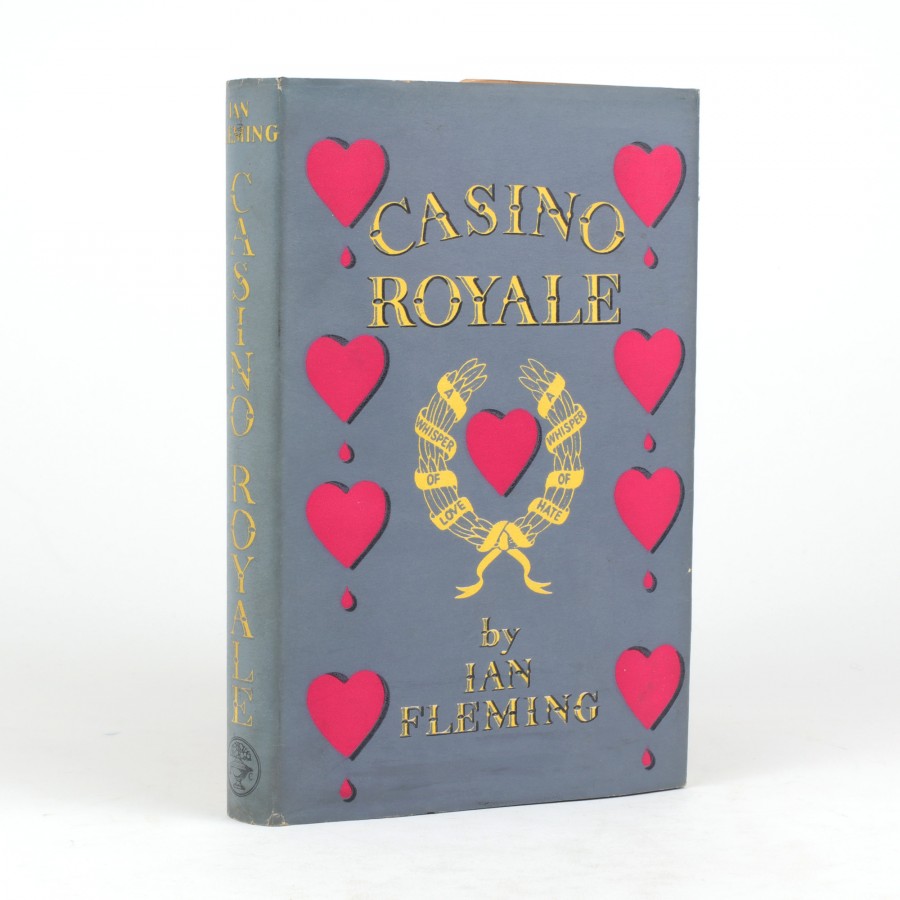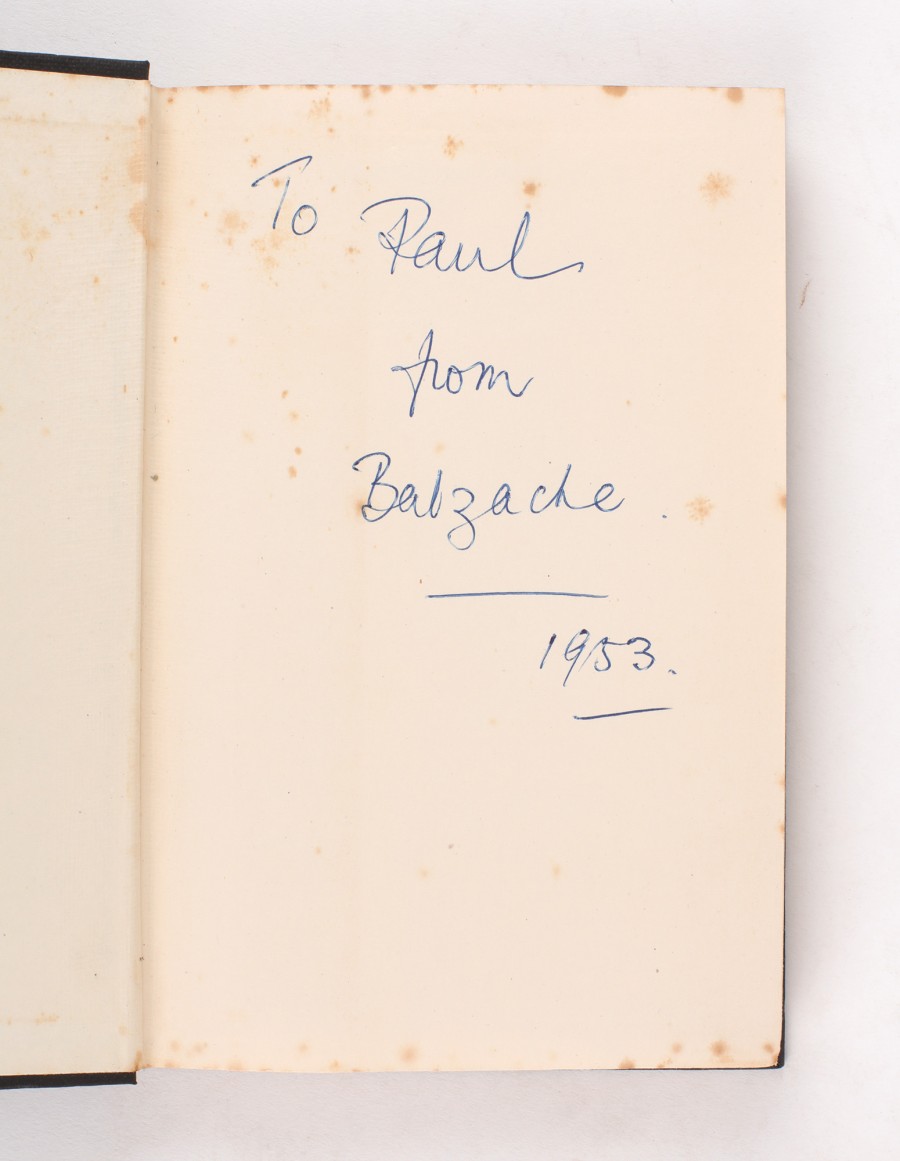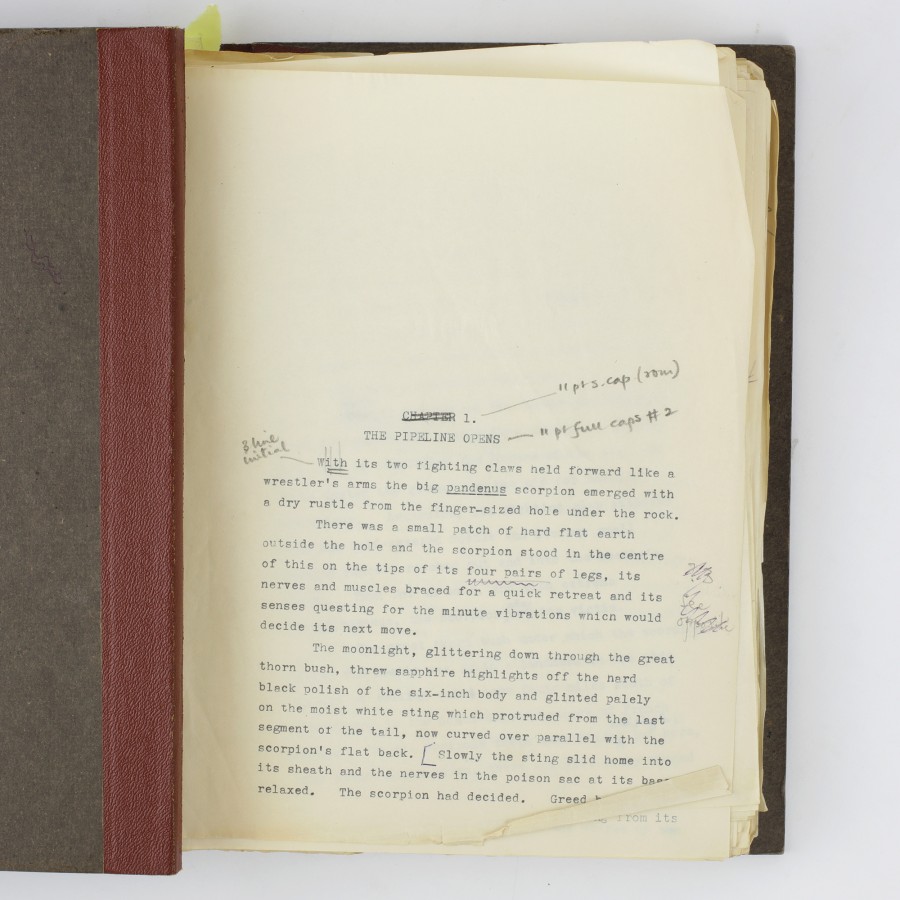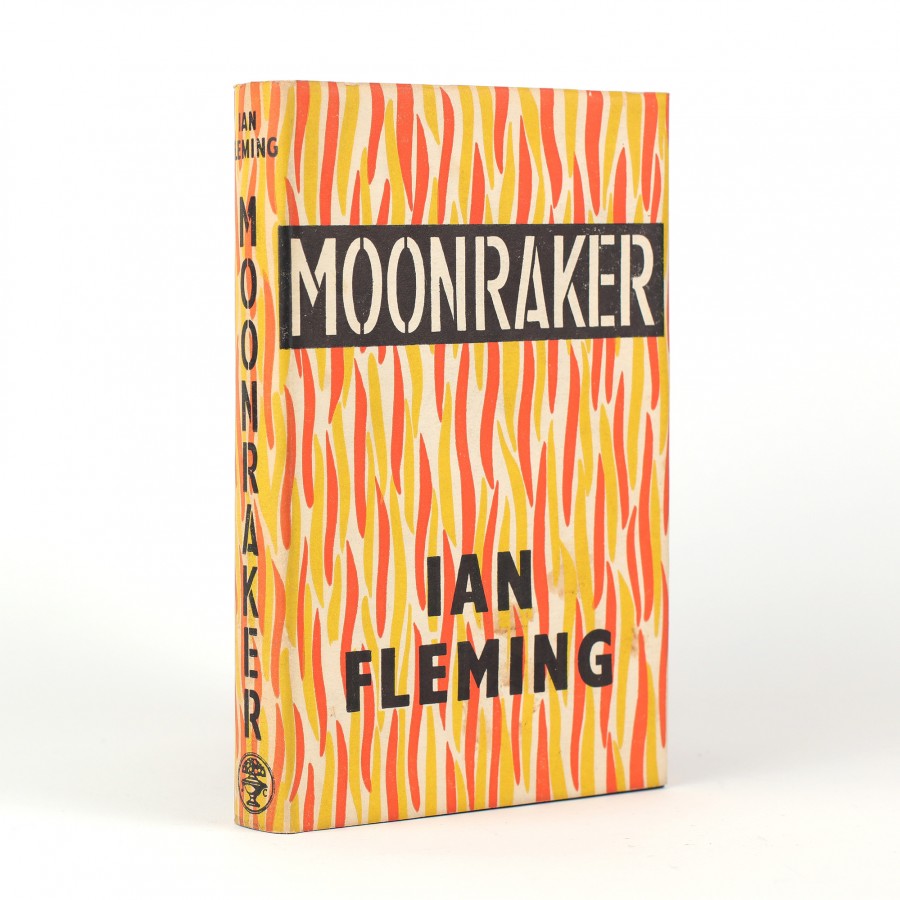Collecting Ian Fleming
11 January 2024
Share
Iconic characters can demand iconic prices.
By Alexander Larman
“The name’s Bond. James Bond.” Five of the most iconic words in cinema, and, of course, they owe their immortality to Commander Ian Fleming, the man who created Bond in 1953’s Casino Royale. He was a character who owed a great deal to his author, given Fleming’s own distinguished career in military intelligence and penchant for wine, women and cigarettes. In doing so, the writer gave the world one of its most beloved heroes. Yet Fleming also remains one of the most avidly collected of all twentieth century novelists, whose books can be found in any self-respecting bibliophile’s collection. Not bad, really, for a man who said of Casino Royale to a friend that “I really am thoroughly ashamed of it ... after rifling through this muck you will probably never speak to me again, but I have got to take that chance.”
Today, a first edition of his first novel inscribed to his fellow novelist Paul Gallico can be bought from Jonkers Rare Books for an impressive £125,000; an unsigned copy of the same book in what Christiaan Jonkers calls “well used, but not irredeemable condition” will set you back a rather less dear but still punchy £22,500. Yet Fleming is one of those authors, like J.R.R. Tolkien and Roald Dahl, whose books represent a blue-chip investment; they have been in fashion for seventy years, show no signs of getting less popular, and, as the casting of the next James Bond actor is eagerly awaited – my money’s on James Norton – continue to represent the pinnacle of contemporary book collecting.


Ian Fleming, Casino Royale. Inscribed to Paul Gallico. Images courtesy of Jonkers Rare Books.
According to Jonkers, who sells the books from his shop in Henley-on-Thames, the reasons for their success is straightforward. “Despite the books appearing somewhat dated now, Fleming created something with a timeless appeal in James Bond, with his juxtaposition of just-unobtainable glamour and all too obvious flaws that can be easily appreciated by audiences over a seventy-year span with very little fundamental change.
And Fleming was a journalist who wrote in a very spare but meticulously detailed way, presenting the reader with all the information needed to form a precise image, but with very little unnecessary verbiage. This made the style and feel of the books very easy to translate to film scripts.”
Jonkers initially began dealing in the books in the early Nineties, and now says “One of my earliest projects was helping a customer who had become quite successful in the entertainment world to build a Fleming collection. We started with a set of first editions in perfect condition, something that was quite attainable then, but not valued to the extent it is now. They were often just sitting on people’s bookshelves unnoticed. Not infrequently, I would be visiting friends at home and they would have a small clutch of Flemings sitting on the bookshelf, which had been bought by their parents as they came out in the 50s and 60s, read once and left untouched.” He quips “I think the book trade must have thought I was printing them.”
The signed copy Jonkers is currently selling is rare, because, as he notes, “though happy to inscribe his books, Fleming only tended to do so for friends and acquaintances.” When asked if he has any more affordable titles, he remarks “We currently have a copy of Thunderball, inscribed to a journalist colleague for £12,500 which is about as inexpensive as you might expect to pay for an inscribed first edition. One occasionally sees signed reprints for sale which should cost less, but are very much less desirable.
One also sees forgeries on the market from time to time. When buying material of this sort the usual rules of common sense apply: buy from an experienced and knowledgeable bookseller and if it looks too good to be true, it probably is.”
Yet these pale in comparison to the pièce-de-résistance the dealer is offering, Fleming’s original corrected typescript of Diamonds are Forever, copiously annotated by the author in his distinctive blue biro, and retailing for a cool £350,000. As Jonkers says of it, “I have handled a number of manuscripts, though none as early or as heavily reworked as this.

The final revised typescript of 'Diamonds Are Forever' with Ian Fleming's autograph revisions throughout. Image courtesy of Jonkers Rare Books.
The annotations are interesting, not just as historical artefacts, but also as an insight in Fleming’s creative process of bringing James Bond into print. It is now the third time I have owned it, having bought it back twice within the space of 20 years. It really should be in a museum or long-term private collection.”
There are other hugely desirable items of Fleming memorabilia that Jonkers has sold in the past – a copy of Live and Let Die inscribed to Winston Churchill, for instance, and an edition of Moonraker signed for Raymond Chandler – but as the bookseller comments, ‘One of the attractive things about collecting Fleming is that all of the books are relatively attainable. There are esoteric oddities, variants, copies in different coloured ‘trail’ bindings etc., but most collectors aren’t very interested in those. Of the mainstream books, the most difficult to find is probably a Moonraker in perfect condition. The dustwrapper design is orange and yellow flames on a white background and almost as soon as the book is exposed to light the orange and yellow fade and the white tans. I have probably only seen two or three genuinely perfect examples of the jacket in some thirty years.”

Moonraker Ian Fleming, this first edition on offer by Jonkers Rare Books is one of those rare copies with little fading to the dustwrapper. Image courtesy of Jonkers Rare Books.
The less well-heeled Fleming collector does have a few options; a copy of the final James Bond book, Octopussy and the Living Daylights, can usually be found for around £200, and the first editions of the Pan paperbacks retail for under £100, even now. Yet there has also been mild controversy when it comes to the author lately, with Live and Let Die being edited and rewritten at the behest of ‘sensitivity readers’, deleting racial slurs that are thought to be unpalatable today. Does Jonkers ever believe that there will be a time when Fleming and Bond shake, rather than stir, book collectors? “I think that Fleming’s books will have a following for at least a generation after they stop making the films. After that point it is hard to tell whether the cultural momentum would be enough to propel the Fleming bandwagon in perpetuity, but I think, in any case, it is unlikely that anyone living today will see a time where Ian Fleming and James Bond is not well known.”
007 may have had a licence to kill, but, in today’s ever-fertile bibliophile market, dealers in his work have a licence to print money, as the titles become ever-more sought after: a state of affairs that shows no signs of changing.
By Alexander Larman
“The name’s Bond. James Bond.” Five of the most iconic words in cinema, and, of course, they owe their immortality to Commander Ian Fleming, the man who created Bond in 1953’s Casino Royale. He was a character who owed a great deal to his author, given Fleming’s own distinguished career in military intelligence and penchant for wine, women and cigarettes. In doing so, the writer gave the world one of its most beloved heroes. Yet Fleming also remains one of the most avidly collected of all twentieth century novelists, whose books can be found in any self-respecting bibliophile’s collection. Not bad, really, for a man who said of Casino Royale to a friend that “I really am thoroughly ashamed of it ... after rifling through this muck you will probably never speak to me again, but I have got to take that chance.”
Today, a first edition of his first novel inscribed to his fellow novelist Paul Gallico can be bought from Jonkers Rare Books for an impressive £125,000; an unsigned copy of the same book in what Christiaan Jonkers calls “well used, but not irredeemable condition” will set you back a rather less dear but still punchy £22,500. Yet Fleming is one of those authors, like J.R.R. Tolkien and Roald Dahl, whose books represent a blue-chip investment; they have been in fashion for seventy years, show no signs of getting less popular, and, as the casting of the next James Bond actor is eagerly awaited – my money’s on James Norton – continue to represent the pinnacle of contemporary book collecting.


Ian Fleming, Casino Royale. Inscribed to Paul Gallico. Images courtesy of Jonkers Rare Books.
According to Jonkers, who sells the books from his shop in Henley-on-Thames, the reasons for their success is straightforward. “Despite the books appearing somewhat dated now, Fleming created something with a timeless appeal in James Bond, with his juxtaposition of just-unobtainable glamour and all too obvious flaws that can be easily appreciated by audiences over a seventy-year span with very little fundamental change.
And Fleming was a journalist who wrote in a very spare but meticulously detailed way, presenting the reader with all the information needed to form a precise image, but with very little unnecessary verbiage. This made the style and feel of the books very easy to translate to film scripts.”
Jonkers initially began dealing in the books in the early Nineties, and now says “One of my earliest projects was helping a customer who had become quite successful in the entertainment world to build a Fleming collection. We started with a set of first editions in perfect condition, something that was quite attainable then, but not valued to the extent it is now. They were often just sitting on people’s bookshelves unnoticed. Not infrequently, I would be visiting friends at home and they would have a small clutch of Flemings sitting on the bookshelf, which had been bought by their parents as they came out in the 50s and 60s, read once and left untouched.” He quips “I think the book trade must have thought I was printing them.”
The signed copy Jonkers is currently selling is rare, because, as he notes, “though happy to inscribe his books, Fleming only tended to do so for friends and acquaintances.” When asked if he has any more affordable titles, he remarks “We currently have a copy of Thunderball, inscribed to a journalist colleague for £12,500 which is about as inexpensive as you might expect to pay for an inscribed first edition. One occasionally sees signed reprints for sale which should cost less, but are very much less desirable.
One also sees forgeries on the market from time to time. When buying material of this sort the usual rules of common sense apply: buy from an experienced and knowledgeable bookseller and if it looks too good to be true, it probably is.”
Yet these pale in comparison to the pièce-de-résistance the dealer is offering, Fleming’s original corrected typescript of Diamonds are Forever, copiously annotated by the author in his distinctive blue biro, and retailing for a cool £350,000. As Jonkers says of it, “I have handled a number of manuscripts, though none as early or as heavily reworked as this.

The final revised typescript of 'Diamonds Are Forever' with Ian Fleming's autograph revisions throughout. Image courtesy of Jonkers Rare Books.
The annotations are interesting, not just as historical artefacts, but also as an insight in Fleming’s creative process of bringing James Bond into print. It is now the third time I have owned it, having bought it back twice within the space of 20 years. It really should be in a museum or long-term private collection.”
There are other hugely desirable items of Fleming memorabilia that Jonkers has sold in the past – a copy of Live and Let Die inscribed to Winston Churchill, for instance, and an edition of Moonraker signed for Raymond Chandler – but as the bookseller comments, ‘One of the attractive things about collecting Fleming is that all of the books are relatively attainable. There are esoteric oddities, variants, copies in different coloured ‘trail’ bindings etc., but most collectors aren’t very interested in those. Of the mainstream books, the most difficult to find is probably a Moonraker in perfect condition. The dustwrapper design is orange and yellow flames on a white background and almost as soon as the book is exposed to light the orange and yellow fade and the white tans. I have probably only seen two or three genuinely perfect examples of the jacket in some thirty years.”

Moonraker Ian Fleming, this first edition on offer by Jonkers Rare Books is one of those rare copies with little fading to the dustwrapper. Image courtesy of Jonkers Rare Books.
The less well-heeled Fleming collector does have a few options; a copy of the final James Bond book, Octopussy and the Living Daylights, can usually be found for around £200, and the first editions of the Pan paperbacks retail for under £100, even now. Yet there has also been mild controversy when it comes to the author lately, with Live and Let Die being edited and rewritten at the behest of ‘sensitivity readers’, deleting racial slurs that are thought to be unpalatable today. Does Jonkers ever believe that there will be a time when Fleming and Bond shake, rather than stir, book collectors? “I think that Fleming’s books will have a following for at least a generation after they stop making the films. After that point it is hard to tell whether the cultural momentum would be enough to propel the Fleming bandwagon in perpetuity, but I think, in any case, it is unlikely that anyone living today will see a time where Ian Fleming and James Bond is not well known.”
007 may have had a licence to kill, but, in today’s ever-fertile bibliophile market, dealers in his work have a licence to print money, as the titles become ever-more sought after: a state of affairs that shows no signs of changing.

